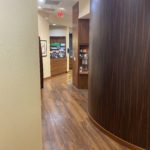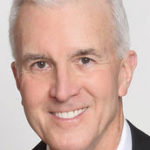By Thomas P. Arnold, OD, FSLS

April 21, 2021
Your patient flow and staff workflow directly impact the patient experience and profitability. Creating the right office flow has been an integral part of my practice’s success.
We’ve generated over $2 million gross income annually for over a decade. For 10 years, or more, we were at $2.1 million gross annually, and slowly increased to a high of $2.95 million gross in 2017. In 2018-19 I traveled extensively lecturing on sclerals, so our revenue dropped back to $2.6 million gross. However, even in the year of COVID, we generated almost $2.3 million in gross income.
Here are essential steps to ensure maximum efficiency in how your patients move through your office and how your staff works, so both patient satisfaction and practice profitability are improved.
Make Sure You Are Adequately Staffed
When practices are young and growing there can be a temptation to hire fewer employees to keep payroll expenses down. However, your staff is as much a part of the practice as the doctor…..in some ways even more so because patients will likely spend more time interacting with key personnel than with you. Even the most loyal employees will miss work sometimes – sick children, car trouble, babysitter absent or daycare closed. And sometimes staff just “catch a bug,” and during the pandemic, we have learned to take this seriously.
Therefore, it is important to have enough staff to pick up the slack from absent colleagues. Being short-staffed creates tension among the employees who do come to work, and this can be seen by patients. It is critical that telephone calls are answered promptly and in a calm manner. Patients need to be greeted upon entering with a friendly smile and kind word. Overworked and stressed employees do not make a favorable impression.
Short-staffed practices also experience slowed patient flow, so that long wait times in the reception area and bottlenecks in the pretesting area are created. Not having enough staff can also result in too many people in the optical at one time for the opticians to provide the kind of attention needed to capture sales.
Cross-Train, But Don’t Overdo It
Once you have enough staff, the question becomes “Who does what?” It is common for many practices to have a front desk receptionist/cashier, one or two doctors’ assistants and maybe an optician if eyewear is sold. In a larger practice, there may be two people at the front desk – a cashier and someone to answer the telephone and verify insurance coverage. It is a good idea to cross-train so that a front desk person could perform a visual field or OCT test, for instance. Or maybe someone who normally works as a tech can help to check a patient out or dispense eyewear.
Other Articles to Explore
However, resist the temptation to move people around in a rotation. In my early days of practice, we did this with the idea that employees might become bored doing the same thing repeatedly. In the same vein, we put an emphasis on “cross training” so that anyone could do anything. Both of these assumptions turned out to be false.
You may be familiar with the old adage, “If everyone is responsible, no one is responsible.” When personnel are constantly shifted about, this is exactly what happens. Insurance verification falls through the cracks, contact lenses do not get ordered, problems with the optical labs or frame vendors do not receive follow-up. It is too easy to say, “I thought you were going to take care of that.”
In our experience, staff are more comfortable doing a job they are familiar with and do well. Performing tasks outside of their comfort zone may cause undue stress, result in mistakes and may lead to the appearance of a lack of professionalism. None of this is conducive to a smooth patient flow and building a thriving practice.
Create a Schedule that Maximizes Patient Volume Without Overwhelming Your Capacity
In our practice, we have two ODs who work a total of 5.5 days per week between them. Here is how we use scheduling to manage patient flow and staff workflow:
a. Each OD schedules two comprehensive exams and one “progress” or short visit (e.g. “red eye,” CL follow-up; glasses Rx check) every hour
b. The times are shifted 15 minutes between the doctors.
i. e.g. Dr. A is scheduled at: 9:00/9:15/9:30 – where the 0:15 visit is “short”
ii. Dr. B is scheduled at 9:15/9:30/9:45 – where the 0:30 visit is “short”
c. Thus, there is not a conflict over appointment times for the preliminary exam room (VA check; IOP; auto-refraction; Optos; read current eyeglasses Rx)
Two comprehensive exams per hour with a brief visit in between strikes the right balance between profitability and quality patient care for us. Neither the doctor nor the patient need feel rushed. We are able to create a patient experience in which each feels they have received a high level of professional care and attention.
We have reserved slots for “special testing” (eg, visual fields, OCT, pachymetry) the last visit of the morning before lunch and the last visit of the day. Only one special test per slot. In other words, both doctors cannot schedule a special test at the same time. Also, there is no special testing on Saturdays, as this is our half day.

Dr. Arnold’s office was designed with efficiency in mind. The bend in the hallway gives the exam room and doctors greater privacy and helps prevent patients from spying a doctor and heading back on their own to “ask a quick question.”
Create a Physical Space that Maximizes Efficiency
I have had two offices in my career. Both were shaped like long rectangles. The first was smaller and had a direct view from the reception desk all the way past the exam rooms to the back. My intention was that I could keep an eye on the front desk while moving between exams. This turned out to be a mistake.
There was, inevitably, that patient who spied me from the front and came racing back “just to ask a question.” This was never quick and easy and placed me in an awkward position. When we built the new office, we created a bend in the path, so the exam room hallway could not be viewed from the front.
With so many special testing instruments available today (eg, OCT, visual field analyzers, meibomographers, tomographers, profilometers) it is best to put them in a separate location from the pretesting equipment. In our previous office they were all in one room. Therefore, any special test precluded pretesting for routine exams.
Our pretesting room currently consists of an autorefractor, automated lensometer, Optos fundus camera, iCare tonometer and visual acuity chart. The special testing room has all the other equipment.
One last feature that we carried over from the original office are plastic flags of different colors outside each exam room. Sometimes the old school approach is still the best. Each doctor has their own assigned color, so we know who is in each room. An additional colored flag outside the exam room (red, blue, green, yellow, black and white) indicates the type of exam being performed in that room.
Just a glance down the hall will alert support staff to the complexity of the exam or service being performed. This, in turn, gives staff a sense of when each patient encounter will likely be finished. Patient flow can then be estimated.
With attention to the details, it is possible to create an office in which efficiency, patient satisfaction and profitably are increased.
 Thomas P. Arnold, OD, FSLS, is a partner with Memorial Eye Center at Sugar Land. To contact him: tarnold@memorialeyecenter.com
Thomas P. Arnold, OD, FSLS, is a partner with Memorial Eye Center at Sugar Land. To contact him: tarnold@memorialeyecenter.com





















